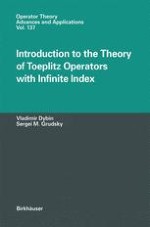
2002 | OriginalPaper | Buchkapitel
Introduction
verfasst von : Vladimir Dybin, Sergei M. Grudsky
Erschienen in: Introduction to the Theory of Toeplitz Operators with Infinite Index
Verlag: Birkhäuser Basel
Enthalten in: Professional Book Archive
Aktivieren Sie unsere intelligente Suche, um passende Fachinhalte oder Patente zu finden.
Wählen Sie Textabschnitte aus um mit Künstlicher Intelligenz passenden Patente zu finden. powered by
Markieren Sie Textabschnitte, um KI-gestützt weitere passende Inhalte zu finden. powered by
The Toeplitz operatorT(a) on the real line ℝ induced by a function a given on ℝ is defined by 1$$T(a)f = {P^ + }(af),$$ where P+ is the analytic projector of the space L p (ℝ) , 1 < p < ∞, onto the Hardy subspace H p (∏+) for the upper complex half-plane ∏+. The function a is called the symbol of the operator T(a). To study such operators in the Hardy space H p (∏+) we will assume from now on that a ∈ L∞(ℝ). In the simplest case the symbol a admits a representation 2$$a(x) = {a^ + }(x){\left( {\frac{{x - i}}{{x + i}}} \right)^\kappa }{a^ - }(x),$$ where 3$${({a^ + })^{ \pm 1}} \in {H^\infty }({\prod _ + }), {({a^ - })^{ \pm 1}} \in {H^\infty }({\prod _ - }), \kappa \in \mathbb{Z},$$ which is known as a canonical factorization. The rational function 4$$r(x) = {\left( {\frac{{x - i}}{{x + i}}} \right)^\kappa }$$ plays a determining role in the description of the main qualitative characteristics of the operator T(a). Specifically, for κ > 0 the operator T(a) is left-invertible and dim coker T(a) = κ for κ < 0 it is right-invertible and dim ker T(a) = −κ and for κ = 0 it is invertible. As a consequence, the index of the operator T(a) is equal to −κ, and is also equal to minus the topological index of the function r, which is defined by $$in{d_\mathbb{R}}r = \frac{1}{{2\pi }}\arg r(x)|_{ - \infty }^\infty .$$